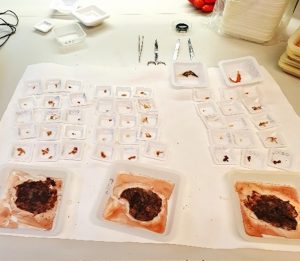Hello, my name is Harald Kjærnli, and I’m in my fifth semester for bachelor’s in biology.Through BIO299,
I’ve joined in a project with the Fjord and Coastal Ecology research group, as I’ve always been interested in marine biology. I took this course to experiencing how scientific work was in a more real setting, and not limited to predetermined lab experiments.
Lately in the fjord ecosystems in western Norway, Periphylla periphylla have had a large population increase. For my project I worked with post-doc Natalya Gallo and joined in to add data surrounding the ecological role of this newly abundant species.
Now some background information regarding my project.
Background info
HypOnFjordFish, is a large research project based in the western Norwegian fjords,
where many different disciplines join to better understand our marine resources
and the effects the changing climate is having on the fjord community.
https://hyponfjordfish.w.uib.no/

Figure 2: Pelagic hauls from BIO325 cruise, night and day. Students sifting through P. periphylla to get access to the fish,
useful for their study, with some jellyfish put aside for this one
Periphylla periphylla is a deep-sea jellyfish, called the helmet jellyfish. Within the last 40 years, P. periphylla’s prominence specifically in the Norwegian fjords has massively increased. In the fjords P. periphylla performs diel migration, staying deep during the day and coming up to shallower waters at night, generally hunt copepods, shrimp and smaller fish, as well as feed on the eggs and larvae of food fish.
The results of the data from the BIO325 cruises shows that in 27% of the hauls, Periphylla made up ¾ of the biomass.
Trophic levels are an indication of an organism’s place in the food web. Trophic means in relation to nutrition, and low-trophic level species are those that feed mainly on primary producers, while higher trophic level species eat other consumers. Historically, jellyfish have been considered trophic dead ends, as their tissue is much less nutritionally valuable.
However, due to the changing climate, many places have seen an increase in jellyfish proliferation. Unlike fish, jellyfish can survive in more hypoxic and acidic environments. More direct human intervention also aids jellyfish blooms, like fishing up the competition.
Despite this, jellyfish proliferation is also a detriment for human capital. Jellyfish clog fishing nets, eat the eggs and larvae of food fish, and bother tourists, which is probably why the fishing industry is suddenly more interested in helping the study of ecological factors.
What I worked on
In my project, I examined what consequences the increase in Periphylla may have on the fjord ecosystem. Specifically, my work has contributed to determining the potential true biomass of
P. periphylla, by weighing, measuring, and drying samples of Periphylla tissue. This can shed light on the ecological role that this jellyfish might play as its population continues to grow.
I originally hypothesized that there would be differences in water content in the jellyfish across their large size range (1-3000 g).
I expected that larger individuals would have higher water content than smaller individuals. However, I found this not to be true during my drying experiments. I also hypothesized that different tissue types would have different water content. My drying experiments supported this hypothesis. The plan was also to start working on making stable isotope samples, however I could not start with that within the timeframe of the course
What I found out
During my drying experiments I tested the water content of;
Periphylla samples with remaining tissues, the different prey found within the jellyfish,
and five tissue types. These tissue types were:
- Two tentacles combined, to account for size differences
- Upper tentacle tissue, connecting to the main body
- The ectodermal tissue on the bell
- The striated musculature tissue, found on the oral side
- Gonadal tissues, with and without eggs
My main findings have shown that Periphylla are on average 95.6% water, with certain tissue types like the striated tissues over the tentacles having among the most consistent results.Gonad samples are the densest, but the water content fluctuate depending on sample size or the presence of eggs. The water content of Periphylla prey, small fish and shrimp,
was around 80 and 85% respective, showing the nutritional disparity compared to gelatinous tissues
What I’ve personally learned from this project is that one should expect fallbacks regarding time scheduling. Just slightly after I began my project, another course that I took had a three-week marathon of lectures and labs, meaning that around a month was lost.
There are still many gaps in the knowledge that I worked on, like not getting started on the stable isotope,
meaning that the effect Periphylla have on predation in the fjord ecosystem is still not known.
However, I believe the data collected and conclusions I’ve drawn,will help future studies in answering this.
References:
(HypOnFjordFish website)
https://hyponfjordfish.w.uib.no/
(BIO325 field cruise)
Salvanes, A.G.V. et al. (2018) Marine ecological field methods : a guide for marine biologists and fisheries scientists. Hoboken,
New Jersey: Wiley.
Sources
Geoffroy, M., Berge, J., Majaneva, S. et al. Increased occurrence of the jellyfish Periphylla periphylla in the European high Arctic. Polar Biol
Hays GC, Doyle TK, Houghton JDR. A Paradigm Shift in the Trophic Importance of Jellyfish?
Purcell JE, Uye S, Lo W (2007) Anthropogenic causes of jellyfish blooms and their direct consequences for humans: a review.


